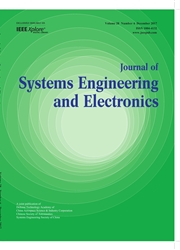

 中文摘要:
中文摘要:
Over the past few decades, the world has witnessed a rapid growth in mobile and wireless networks(MWNs) which significantly change human life. However, proliferating mobile demands lead to several intractable challenges that MWN has to face. Software-defined network is expected as a promising way for future network and has captured growing attention. Network virtualization is an essential feature in software-defined wireless network(SDWN), and it brings two new entities, physical networks and virtual networks. Accordingly, efficiently assigning spectrum resource to virtual networks is one of the fundamental problems in SDWN. Directly orienting towards the spectrum resource allocation problem, firstly, the fluctuation features of virtual network requirements in SDWN are researched, and the opportunistic spectrum sharing method is introduced to SDWN. Then, the problem is proved as NP-hardness. After that, a dynamic programming and graph theory based spectrum sharing algorithm is proposed.Simulations demonstrate that the opportunistic spectrum sharing method conspicuously improves the system performance up to around 20%–30% in SDWN, and the proposed algorithm achieves more efficient performance.
 英文摘要:
英文摘要:
Over the past few decades, the world has witnessed a rapid growth in mobile and wireless networks(MWNs) which significantly change human life. However, proliferating mobile demands lead to several intractable challenges that MWN has to face. Software-defined network is expected as a promising way for future network and has captured growing attention. Network virtualization is an essential feature in software-defined wireless network(SDWN), and it brings two new entities, physical networks and virtual networks. Accordingly, efficiently assigning spectrum resource to virtual networks is one of the fundamental problems in SDWN. Directly orienting towards the spectrum resource allocation problem, firstly, the fluctuation features of virtual network requirements in SDWN are researched, and the opportunistic spectrum sharing method is introduced to SDWN. Then, the problem is proved as NP-hardness. After that, a dynamic programming and graph theory based spectrum sharing algorithm is proposed.Simulations demonstrate that the opportunistic spectrum sharing method conspicuously improves the system performance up to around 20%–30% in SDWN, and the proposed algorithm achieves more efficient performance.
 同期刊论文项目
同期刊论文项目
 同项目期刊论文
同项目期刊论文
 Performance analysis for buffer-aided communication over block Rayleigh fading channels: queue lengt
Performance analysis for buffer-aided communication over block Rayleigh fading channels: queue lengt Improving the Energy Efficiency of Two-Tier Heterogeneous Cellular Networks through Partial Spectrum
Improving the Energy Efficiency of Two-Tier Heterogeneous Cellular Networks through Partial Spectrum Joint Mode Selection and Resource Allocation for Cellular Controlled Short-Range Communication in OF
Joint Mode Selection and Resource Allocation for Cellular Controlled Short-Range Communication in OF Performance Study of A Deep Space Communications System with Low-Density Parity-Check Coding under S
Performance Study of A Deep Space Communications System with Low-Density Parity-Check Coding under S Time-Frequency Training OFDM with High Spectral Efficiency and Reliable Performance in High Speed En
Time-Frequency Training OFDM with High Spectral Efficiency and Reliable Performance in High Speed En Generalised Spatial Modulation System with Multiple Active Transmit Antennas and Low Complexity Dete
Generalised Spatial Modulation System with Multiple Active Transmit Antennas and Low Complexity Dete Corrections to the Proof in `Coordinated Beamforming for the Multicell Multi-Antenna Wireless System
Corrections to the Proof in `Coordinated Beamforming for the Multicell Multi-Antenna Wireless System Interference-Aware Relay Selection Scheme for Two-Hop Relay Networks With Multiple Source-Destinatio
Interference-Aware Relay Selection Scheme for Two-Hop Relay Networks With Multiple Source-Destinatio Distributed Power Allocation for Coordinated Multipoint Transmissions in Distributed Antenna Systems
Distributed Power Allocation for Coordinated Multipoint Transmissions in Distributed Antenna Systems Analysis of Boundedness and Convergence of Online Gradient Method for Two-Layer Feedforward Neural N
Analysis of Boundedness and Convergence of Online Gradient Method for Two-Layer Feedforward Neural N Distributed Multichannel and Mobility Aware Cluster-based MAC Protocol for Vehicular Ad-hoc Networks
Distributed Multichannel and Mobility Aware Cluster-based MAC Protocol for Vehicular Ad-hoc Networks Optimal Combination of Base Station Densities for Energy-Efficient Two-Tier Heterogeneous Cellular N
Optimal Combination of Base Station Densities for Energy-Efficient Two-Tier Heterogeneous Cellular N Active interference cancellation-aided QoS-aware distributed ARQ for cognitive radios with heterogen
Active interference cancellation-aided QoS-aware distributed ARQ for cognitive radios with heterogen Weighted sum-rate maximization for multi-user SIMO multiple access channels in cognitive radio netwo
Weighted sum-rate maximization for multi-user SIMO multiple access channels in cognitive radio netwo Traffic-Aware Base Station Sleeping Control and Power Matching for Energy-Delay Tradeoffs in Green C
Traffic-Aware Base Station Sleeping Control and Power Matching for Energy-Delay Tradeoffs in Green C Throughput Improvement by Joint Relay Selection and Link Scheduling in Relay-Assisted Cellular Netwo
Throughput Improvement by Joint Relay Selection and Link Scheduling in Relay-Assisted Cellular Netwo Next-Generation Digital Television Terrestrial Broadcasting Systems: Key Technologies and Research T
Next-Generation Digital Television Terrestrial Broadcasting Systems: Key Technologies and Research T Simplified Direct Search Method for Constrained Nonlinear Mixed-Integer Programming of Two-Dwell Ser
Simplified Direct Search Method for Constrained Nonlinear Mixed-Integer Programming of Two-Dwell Ser EXIT-Chart-Matching-Aided Near-Capacity Coded Modulation Design and a BICM-ID Design Example for Bot
EXIT-Chart-Matching-Aided Near-Capacity Coded Modulation Design and a BICM-ID Design Example for Bot 期刊信息
期刊信息
